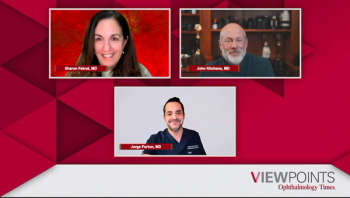
ASCRS 2024: George O. Waring IV, MD, shares early results of bilateral implantation with novel IOL technology
George O. Waring IV, MD, FACS, highlighted preliminary data from an open-label clinical trial, where his site was 1 of 4 in the US.
George O. Waring IV, MD, FACS, shared preliminary data with Ophthalmology Times from his ASCRS presentation, where his site was 1 of 4 in the US involved in an open-label clinical trial examining the results of bilateral implantation with novel IOL technology (Odyssey; Johnson & Johnson).
Video Transcript
Editor’s note - The following transcript has been lightly edited for clarity.
George O. Waring IV, MD FACS:
Hi, it's George Waring from the Waring Vision Institute in Mount Pleasant, South Carolina. We're here in chilly Boston, Massachusetts, at ASCRS 2024 with a lot of exciting activity...a lot of big news. One of the big things that we're really excited to get to present at the meeting this year is some of the first clinical trial data for a brand-new intraocular lens by Johnson & Johnson called the Odyssey. Now, the Odyssey is really a new concept in IOL design.
This is built from ground up with artificial intelligence-driven goals in mind for maximizing quality of vision, maximizing range, and refractive tolerance. That's something that is really gaining more and more importance, as we understand how human eyes can change over time in a way that's hard to predict. So we were lucky to participate as 1 of 4 sites in the US in an open-label trial to evaluate the clinical performance of bilateral Odyssey implantation. And this was the nontoric version; now the toric is available. And this was over 50 eyes enrolled. The results were quite impressive and really mirrored our experience as well. Distance uncorrected binocular was 20/20 +2, intermediate 20/20 -2, and for near was J2. So a really fabulous result. And this was at 1 month, by the way.
We also looked at defocus curves. And what we found that was from plano to -250 greater than 20/20 20/32 vision was maintained and achieved. We looked at patient reported outcomes and found very high levels of satisfaction and spectacle independence. Again, this was above 90% for satisfaction and close to 90% for spectacle independence.
There's some really unique features about this lens technology that I think are important to appreciate and understand. Number one, this uses high resolution lathing not only in the manufacturing process, but also in the design....so this has a relief on the echelette. It's not a point. It's a rounded echelette that is much better defined due to high-resolution lathing process. That reduces light scatter. It reduces dysphotopsia. We have real-world data that actually reported 0% starbursts—that is from mild, moderate, or severe—and very, very low incidence of glare or halo. We're talking about 3% of severe glare or halo—so very, very favorable dysphotopsia profile, and this lens meets a new ISO standard of full vision range lens.
So really, for the first time, we've got qualitative, fabulous contrast sensitivity. We've got quantitative with the full range of vision lens with very broad defocus curves, and with an excellent quality of vision, reduced dysphotopsia, and it really kind of brings everything to the table. So we're really excited about this. We've really moved primarily to binocular Odyssey lens implantation in our practice, and it's just a great time to get to do what we're doing.
Newsletter
Don’t miss out—get Ophthalmology Times updates on the latest clinical advancements and expert interviews, straight to your inbox.








































